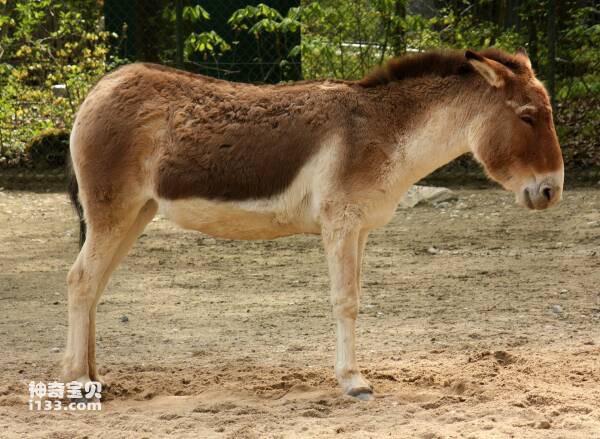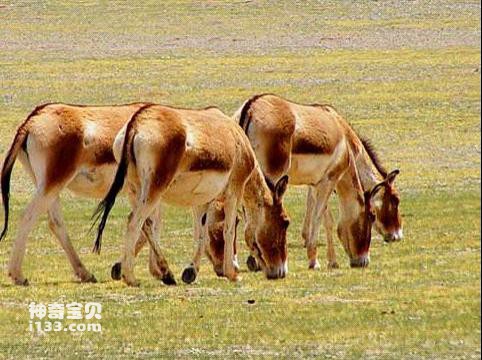The Tibetan wild ass (scientific name: Equus kiang; Tibetan: རྐྱང་།, Wiley transliteration: khyang), also known as the Tibetan wild ass, is a large equid mammal that is distributed in the Qinghai-Tibet Plateau at an altitude of 4000-7000 meters. The largest of all wild donkeys, with an average shoulder height of 140 cm. They are related to the Persian wild ass, and some taxonomists classify it as a subspecies of the Persian wild ass. The Tibetan wild ass is also known as the Asian wild ass. Its body shape is similar to a mule that is a cross between a donkey and a horse. Because its tail is slightly like a horse's tail, some people call it "wild horse".

The head of the Tibetan wild ass is short and wide, the snout is slightly rounded and blunt, the ear shell is more than 170 mm long, the mane is short and straight, the tail mane is born in the second half of the tail or 1/3 of the tail end, the limbs are thick, and the inside of the forelimbs are even. There is a round corpus callosum, commonly known as "night eye", and the hooves are narrow and high. The snout is milky white, the back of the body is brown or dark brown (the summer hair is slightly black), the flank hair is darker to dark brown, from the back end of the shoulder neck hyena along the back to the tail, there is a significantly narrower tan or Dark brown ridges, commonly known as "back velvet". There is an obvious brown stripe on the outside of the shoulder blades. There is a typical white wedge-shaped spot on the back of the shoulder. The front and ventral corners of this spot are arc-shaped, and the abdomen and the inside of the limbs are white. , the light-colored area on the abdomen obviously extends to the sides of the body, the outside of the limbs are light brown, and the white on the arms blends with the surrounding body color without obvious boundaries. The summer hair of adults is darker and the winter hair is lighter. The larval hair is darker, sandy-yellow, and the hair is very long. After molting in the second summer, the hair color is similar to that of adults.

Tibetan wild ass is a plateau animal. It lives in groups at an altitude of 3,600 meters to 5,400 meters. It has strong tolerance to cold, sun, wind and snow. Most of them form small groups of 5 or 6 animals. Large groups number around 10 animals, and the largest groups can reach hundreds. Small groups are led by a male donkey and live a nomadic life. They come from desert or hilly areas to water sources in the early morning to drink water. They spend most of the day gathering on grasslands near water sources to feed and rest, and return to the depths of the desert in the evening. The way Tibetan wild ass walks is in a file with little disorder, with the male donkey leading, the young donkey in the middle, and the female donkey at the end. Most of the roads traveled by the Tibetan wild ass form an obvious "donkey trail". There are large piles of excrement in the places they pass, so it is easy to identify their movement routes. From the place of residence to the water source pasture, the Tibetan wild donkey has to run more than 20 kilometers every day. It has great mobility and is sometimes compared with the Tibetan antelope. Other artiodactyls live in the same place, feeding on alpine plants and can go several days without drinking water.
animal tags:
We created this article in conjunction with AI technology, then made sure it was fact-checked and edited by a Animals Top editor.